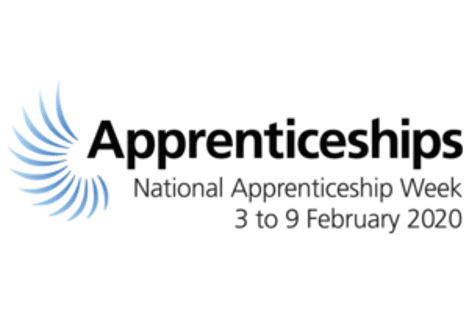From Apprentice to Marketing Specialist – National Apprenticeship Week 2020
It has been three years since I completed an apprenticeship with the Napier Group, and I have recently hit 4 years of working with the agency. As each year passes and the National Apprenticeship Week dawns, I often reflect on how my apprenticeship allowed me to blossom into the Marketer I am today. In this blog I thought I would share my perspective on how an apprenticeship helped kickstart my career.
When I completed my A-Levels back in 2015, I wasn’t certain about what I wanted to do, or where I wanted to go after Sixth Form. I then applied for an apprenticeship at Cambridge Regional College and since then, I haven’t looked back. My progression throughout the programme really gave me the boost I needed to develop critical skills needed in a professional environment.
I chose the apprenticeship path over University, and I strongly believe that it was the right decision for me. Armitage gave me the opportunity to develop my marketing skills and gain valuable career experiences in a real working environment; something I didn’t think was possible at such an early stage. Still today I am grateful for the time and training the company dedicated to my development during my apprenticeship.
During my time as an apprentice, I was able to build my reporting and Microsoft office skills as well as build relationships with clients and work on various exciting B2B marketing campaigns.
In 2017 I became a Marketing Specialist at the Saffron Walden office, and continued my education with the CIM Certificate in Professional Marketing at Cambridge Marketing College. I still continue to learn new things here at Armitage, but my apprenticeship will always remain as one of my highlights.
An apprenticeship worked for me, and I would definitely recommend the programme to anyone looking to make the first step up into a worthwhile career.
Five trends in industrial robotics that are helping to transform manufacturing
Today a Meltwater search of ‘robotics’ headlines tallies 24 results across 12 titles including BBC News, Financial Times and HR magazine. We’re dedicated to following the robot trends across all industries - whether it’s AI being used in finance or robot skeletons being used to help paralysed patients walk again. However, as an agency we are particularly focused on the manufacturing industry where many of our clients are helping UK companies to achieve faster and more flexible production.
There are a number of areas where robotic technology is developing at a rapid rate due to a demand for greater flexibility and speed. It was difficult to come up with only five because there are many different industries within UK manufacturing that have all got the potential to use robots. Nevertheless, we managed to narrow it down. Here are the five that we think are the most exciting to track right now:
Collaborative robots
Initially collaborative robots conjure up visions of smaller robots working alongside people. There are a number of models which have been developed to bring the collaboration to many new areas of production such as electronics, pharmaceutical and automotive as well as small to medium sized manufacturers or workshops. Some of these are able to react to potential collisions and others are ergonomically designed so that if a collision occurs they won’t impact the co-worker.
Lesser known collaborative robots are the large-scale industrial sized robots which are fitted with sensor technology so that they can stop before a human gets within a certain radius. There are even researchers who are exploring code which make robots interact closely with humans - see Madeline Gannon’s work here.
If larger robots are able to collaborate with us, then we could be lifting cars with a wave of our hands in no time.
Machine tending
Robots are able to be adapted into different configurations according to the needs of a customer. In the machine tending industry, there are many different end tools required and robot manufacturers are creating cells which are especially adaptable for this purpose.
There is also a growing skills gap. In this industry many companies are introducing robots to perform the manual loading and unloading so that the skilled employees are able to use their expertise to perform other work steps.
Digital maintenance
With the advent of smartphones and 4G, the possibilities for maintenance engineers, factory managers and CEOs to communicate with elements around the factory floor has expanded. When 5G lands, expect more possibilities. But for now, we are able to share with you that remotely monitoring robot performance is a thing. This is achieved using data analysis and as robots are basically told what to do via a form of data (code), it is possible to analyse this data and provide insightful statistics such as how fast the robots are performing and how many parts have been processed.
A lot of us are getting used to analysing data in the form of social media analytics, for example - if there can be this much insight into engagements on smartphones to drive changes in the way we interact with each other, then analysis of robotics performance could mean great changes for the way that manufacturing is performed - and all at the tap of a screen.
Warehouse logistics
As many of us are ordering goods online whether it’s new clothes or a new sofa, warehouses are having to quickly adapt to manage all of the incoming orders. Warehouse automation has become the differentiator for many online brands. Leading names Ocado and Amazon, for example, have invested heavily in robotic technology. Ocado even has its own innovation department within which they are developing their own robots.
As more of us come to rely on shopping being delivered to our door, greater numbers of warehouses are going to need robots to maintain their position in the market.
Here’s a video of Ocado’s robots in action: https://www.youtube.com/watch?v=4DKrcpa8Z_E
Food and beverage
As food trends proliferate from veganism and vegetarianism through to the paleo diet and sugar-free, the demand on food and beverage brands to continue to churn out relevant products means flexibility is key.
Robots are adept at providing flexibility. They can pick, pack and place products using vision technology which recognises various shapes and sizes. It all comes down to the programming - which is taking less and less time thanks to innovative programming software. Robots also bring the speed - so if a confectionery brand needs to release a timely limited edition chocolate bar, they can do so without too much hassle.
To understand more about what robots have to offer the food and beverage industry, watch this video from Wired https://www.youtube.com/watch?v=SKBHnbYo-4s
Five good reasons to consider apprenticeships
With the tendency of many schools to focus on academic qualifications as a route to a good career, the value of vocational education is often overlooked. This is a shame, because vocational qualifications and training in the form of apprenticeships can often provide a valuable foothold into the real world of work, equipping young people with skills and experience learned literally ‘on the job’.
In this article, we look at five great reasons to consider apprenticeships and explain why vocational qualifications can offer an equally valid alternative to their academic counterparts even up to degree level.
Reason 1 – You learn by doing
While classroom-based teaching suits some people, it can often be a turn-off for those with a more hands-on approach to learning. Vocational qualifications and work-based learning provide the opportunity to discover not just why things work in theory, but also how they how they work in practice. Especially when training is conducted in the workplace, there is the opportunity to learn from the very best teachers – the people who do the task as part of their actual daily job – and to gain honest and informed feedback on your performance.
In many cases, this will entail working alongside people from different backgrounds, age groups and education, introducing an added dimension of interpersonal skills training that can prove invaluable in later life. The ability to communicate with mixed groups of people, for example, is a key skill needed in management, which is why you will often find many senior managers in many different walks of life who started their careers as apprentices.
Reason 2 - Find out what you want to do – and what you don’t
Getting hands-on into a role is a great way of realising that the lifelong ambition you’d been aiming may not be your true calling in life. Steve Wilding, now Field Sales Manager for ABB Measurement & Analytics in the UK and Ireland, sees his apprenticeship as the starting point for his career in engineering sales, after originally having wanted to be a draftsman.
Says Steve: “I was lucky enough to get an apprentice technician role with Vickers, which at the time manufactured electric motors for aerospace and defence applications. At the start, I saw this as a great way of fulfilling my ambition of becoming a draftsman.”
“However, after having worked in several positions around the company, including positions on the factory floor, I realised by the time I got to the design department that I was much more interested in other areas of the company’s activities. Luckily, my apprenticeship gave me scope to choose something else - had I come in straight from school or university, I may well have ended up being stuck in a role I didn’t like.”
It was also Steve’s experience as an apprentice that gave him his next role, which led to the start of a life on the road from which he has never looked back.
“After working in internal sales with Vickers, I took a position with Bourdon, a French manufacturer of instrumentation equipment, becoming sales office manager within a year and then going on the road as a sales engineer. It is this role that really laid the foundations for my career with ABB and a job that I really love doing.”
Reason 3 – Get ahead

While university degrees are often touted as the passport for high salaries and quick advancement, there is no real substitute for experience.
Some of the UK’s most prolific business leaders started as apprentices. Consider, for example, JCB Chairman, Lord Bamford who as Anthony Bamford, started his career as an apprentice for agricultural machinery manufacturer Massey Ferguson. Or Andrew Reynolds Smith, previously CEO of GKN Automotive and now CEO of engineering company Smiths Group, who began his working life as an apprentice for Texas Instruments.
Furthermore, contrary to popular belief, apprenticeships aren’t just limited to the engineering and manufacturing sector. A wide range of professions, from entertainment through to fashion and cooking, offer their own versions of apprenticeships giving candidates the opportunity to gain valuable hands-on experience.
Famously, Jamie Oliver, Gordon Ramsay, Karen Millen, Stella McCartney and even Sir Ian McKellen all started as apprentices in their respective fields, rising through the ranks to become leading names. Some, such as Jamie Oliver and Gordon Ramsay, have even started their own apprenticeship programmes to encourage future generations.
It is also often the case that many people who undertake vocational qualifications and apprenticeships are ahead in their careers by the time their academic counterparts emerge from university. This can provide not just a financial advantage, but also the advantage of accessing opportunities to work in roles in other companies that would not be available to a newly-qualified graduate.
“Not long after finishing his apprenticeship, one of my friends was headhunted by Boeing in the US to work as an interior designer for its aircraft,” says Steve Wilding. It was his four years of experience as an apprentice that gave him this opportunity – a big step for someone still in their early twenties.”

Reason 4 – Earn and learn
The prospect of leaving university laden with tens of thousands of pounds of debt to repay tuition fees is leading many school and college students to rethink their life choices. As a way of both learning and earning, apprenticeships can offer an attractive and worthwhile alternative career path.
One of the biggest benefits of an apprenticeship is the opportunity to earn while you learn. Wage rates vary according to age, with the average wage for an apprentice starting at £3.70 an hour for those aged 16 to 18, £5.90 for those aged 18 to 20 and £7.83 for over 25s. In many cases, there is the prospect of pay increases as time goes on, with rates tending to increase once the first year of training is complete.
In terms of qualifications, apprenticeships offer a great way to combine work with study, with the chance to earn valuable qualifications. Depending on the length of the apprenticeship, candidates can progress from Intermediate level (Level 2), equivalent to GCSE, through to Higher or Degree level (Level 4,5,6 and 7), equivalent to a Foundation, Bachelor or Master’s degree. In addition to providing direct work experience, apprenticeship programmes also incorporate a study element, typically involving day release at an associated college.
Most importantly, unlike university education, there is no repayment expected at the end of the experience. All fees are covered by the employer and the Government. Once the apprenticeship is complete, subject to positions being available, a qualified apprentice can either remain with the organisation they trained with or move on to find other opportunities.
Reason 5 - Make lifelong friendships
In the same way that many people who go to university create lifelong friendships, the same is also true for apprenticeships.
Says Steve Wilding of ABB: “The best thing about doing an apprenticeship is that you’re all in it together. For example, I had friends doing apprenticeships with other companies – to get an idea of what each other did, we would spend time visiting each other’s companies, which gave us a great insight into different ways of working and doing things.
Even though it’s now 28 years since I did my apprenticeship, I’m still in touch with many of my fellow apprentices, many of whom I still meet up with on a regular basis.”
Interested?
If reading this article has helped spark your interest in becoming an apprentice, there are plenty of advice sites available with more information about how to take the next step. The following are examples of some sources of information that may help:
UCAS Apprenticeships page – Everything you need to know about apprenticeships in the UK, with a breakdown of opportunities and schemes by region
GOV.UK page on becoming an apprentice – The UK Government’s page on becoming an apprentice is a good starting point for finding out more about what’s involved and how to prepare yourself for an apprenticeship
The Apprenticeship Guide – A complete step-by-step guide to apprenticeships, containing the full what, how and why of becoming an apprentice and a full list of opportunities by region and industry sector
Get my first job – enter your location and specify which industries you’re interested in to find a choice of suitable apprenticeship opportunities
Inbound Marketing: 5 Tips for Success
Marketing strategies tend to come and go, but Inbound marketing has proved that it is here to stay.
Even after a decade in the marketing world, inbound marketing is perceived as a ‘revolutionary’ concept; viewed as a strategy that works, it delivers excellent results for companies who have taken the plunge and adopted inbound marketing into their marketing strategy.
However, like most strategies, inbound marketing is not exempt from being reviewed; and marketers should evaluate their tactics regularly to ensure they are producing the results you need.
At Napier, we understand what is required to ensure you implement a successful inbound marketing strategy; so, we thought it was only right to share the following 5 tips to ensure your inbound marketing is a success:
Keep Your Content Fresh
Content is the most important aspect of your inbound marketing strategy, but with time limits, and everyday pressures, it can be challenging to keep up with a content schedule. Often this means marketers fall into the habit of repeating posts, resulting in readers seeing the same content again and again.
It’s important to have variety in your content, and although writing new tip sheets, or whitepapers are good, not all content creation needs to be time consuming. A key way to keep your content fresh without spending lots of time, is repurposing content you already have.
Take an interesting and popular blog post. What’s stopping you from turning it into a SlideShare? Or repurposing it as a video? You’ll be surprised by the amount of great content you already have, which is ready and waiting to be re-purposed.
Position Yourself as the Industry Expert
It can be easy to forget that the people searching/reading your content are trying to solve a problem.
For inbound marketing to be a success, you need to create content that captures the attention of your leads, by pre-empting their questions and providing them with the answer to their problems.
You should always write content with your clients/potential clients in mind. What do they struggle with? What are the key problems they have faced in the past? By identifying these issues, and more importantly addressing them in your content, you are instantly positioning your company as the expert in the industry providing the answers the reader is looking for.
Make it Easy for Customers to Contact You
This may seem like an obvious tip, but it is often overlooked in making sure your website makes it easy for people to understand what it is you do and how to contact you.
For example, if your website is your primary source of inbound opportunities, getting in touch with a real person should always be one click away on any page of your website.
If a potential customer is on your website and struggles to find a way to contact you; whether this be via email, phone, or social engagement, you create the risk of losing a qualified lead within seconds.
To avoid this, make sure you have clear CTAs on all key pages of your website directing the visitor to your contact information. Or even better, make sure a clear email address and phone number is featured on every page of your website, by including this information on the footer of your pages.
Increase Inbound Visitors to your Site with SEO Strategies
Put yourself in your prospect shoes, they are requiring a solution to a problem and the first thing they will do is turn to Google.
It is vital that you are properly optimizing your website and content, to increase organic search traffic. By effectively leveraging search engine optimization, targeting high traffic keywords, and analysing data trends, you’re positioning your website and brand higher in the search engine results, increasing your online visibility to inbound visitors.
Don’t Forget to Nurture Your Leads
Often marketers are so focussed on using inbound tactics to attract people, they can forget one crucial element – nurturing your leads.
It is important to remember that once a lead fills in a form or downloads a piece of your content, you need to follow up through email or calling to qualify and nurture the lead.
With Marketo revealing that a massive 96% of visitors viewing your website aren’t ready to buy; lead nurturing is vital in helping your leads through each stage of the funnel, (whether this be through email marketing, lead scoring or list segmentation) until they are in a position to buy.
It can be a tough job to ensure your inbound marketing strategy is running smoothly and successfully; but by utilizing these top five tips, your company will be on the right path to inbound marketing success!
Yokogawa IA's Maaike Goinga - Marketing Expert Interview

- What do you like to do in your spare time (hobbies)?
This year I became a Yoga teacher as it is my hobby and one of my greatest passions. Yoga also gives me the balance I need between my busy work life, and relaxing in my own time.
- What is your favourite book?
‘A Little Life’ by Hanya Yanagihara- a great story about friendship. I read it last year and it really stood out to me.
It’s about a group of friends and how their friendship grows, and it really highlights their respect for one another. The friends take different paths and careers in life, some more successful than others, but their friendship never dies. There is one person that is very vulnerable and never speaks his heart, but everyone is so touched by him. It’s a very fascinating book. I believe Melanie at Peter Bush Communications has also read it.
- What other career would you have chosen if you weren’t in marketing?
I don’t know if I would be in another career other than marketing. It is one of the many things I love, including art and history. Sometimes I dream of having a gallery of my own or even going back to studying. But then there is also Yoga; I could imagine myself having my own Yoga school.
- What do you think have been the biggest changes to B2B marketing in the past 3 years?
I do think the speed of everything has increased over the past few years. For example, the development in technology and how there is now far less patience to get copy/content out there in the market! The market is definitely transforming with the growth of the internet and use of techniques such as marketing automation. Sometimes it gets hard to keep up to date with all the latest information, especially social media, with all the different touchpoints and channels being developed.
- What do you think is the most effective and least effective method of marketing?
I think to be effective in marketing you must be consistent across all your touchpoints with customers and target audiences. Ultimately if you don’t bring consistency and authenticity your brand won’t be associated with how you want it to be, and you will not make a difference.
I also think in this vastly developing digital world, people think that all things digital are ‘the golden bullet’, when in fact I don’t believe that. I do think that digital activities should be linked with some element of face-to-face contact as well, which people now often forget or dismiss. If your business misses out on that human interaction, you are likely to hit those consequences and not achieve your goals.
- If there was one thing you could change about how agencies work with you, what would it be?
For me, I think it works well when we can come together face-to-face, so we can really make a mark. As I work outside of the UK, Yokogawa and Peter Bush Communications often talk over the phone and through email, and we can achieve plenty through those platforms, however, things crop up from time to time which can be forgotten, so it’s great to come together to make a bigger impact, although we cannot spend our lives travelling!
- Can you explain how you define and measure success for your campaigns?
Depending on the type of campaign, success can appear in different forms. If you have set your objectives clearly before the start of your campaign you can measure the behaviours and buying habits of your customers.
- If there was one wish you could make to improve your company's marketing activities, what would it be?
Being in this business is all about the people who I meet and work with. I would really like to see all our people at Yokogawa get a voice in our campaigns to make our professional company approach seem more human.
I believe having more of a human aura to the company to solve customers’ issues, would be appreciated by our customers. They would trust our company more as they know more about the people behind our company. That would be my ‘genie in a bottle’.
HARTING's Natasha Sephton-Pike - Marketing Expert Interview

- What do you like to do in your spare time?
I love to go on walks with my dog, Raspberry Beret (yes, she is named after the Prince song). The muddier and wetter the better is her motto!
- What music do you like?
The dog’s name gave this away; I am huge fan of Prince. He was an artist I grew up listening to and I just fell in love with his songs, his clothes and his voice! His performances and lyrics just blow me away. He truly was one of a kind and paved the way for many other artists to come.
- What other career would you have chosen if you weren’t in marketing?
I would probably have worked in some form of caring capacity, either with the elderly or disabled adults. I enjoy caring for people and helping to enrich their lives, the elderly is a section of society that can often be overlooked and not heard, which is really quite sad. I try to support elderly people in my local community and getting involved with organisations such as Contact the Elderly are a great way to help.
- What do you think have been the biggest changes to B2B marketing in the past 3 years?
- Big data opportunities
- Social media
- Changing audience demographics – particularly in an environment marketing to engineers, the skills gap here presents a unique challenge for how we communicate across this wide split in age and experience.
- What do you think will be the biggest change in the way you approach your campaigns in the next 3 years?
Data driven marketing campaigns to support our customer journey - incorporating our historical learned data about our customers and their interactions with us with external market data to produce tailored material across multiple channels, delivered to the right people at the right time.
- What are your 3 biggest marketing challenges?
- Time to stop and think and celebrate – As marketers, we can often be stuck in the role of project planning and execution, always under time deadlines and running from one project to the next. We find it hard to stop and think ahead; think freely and creatively but also to celebrate our success.
- Evaluating “the latest marketing trend” – What could help us, what is noise? It can be difficult to decipher the value from the noise with new technologies, tools and methodologies developing all the time. As a busy marketing department, understanding and testing what can help you be more efficient and effective is a tricky challenge.
- Proving marketing value – Having systems and processes in place companywide that supports the journey to linking marketing campaigns and interactions with sales. The marketing department must own this ROI project but need support from all areas of the company who are customer facing to truly get a clear picture of the customer journey and how marketing plays it part.
- What do you think is the most effective and least effective marketing activity you, or your company, undertakes (in terms of ROI)?
It is difficult to say, all our activity supports the overall goal of achieving a positive ROI. Some channels we use are easier than others to measure KPIs against such as digital trade press advertising, email marketing and website performance. Other activities such as PR, printed trade press and to some extent exhibitions, can be harder to measure KPIs against. Recording which touchpoints our customers interact with along their journey is the most important ROI activity that we do, we can see the whole picture, not just a snapshot of the quick and easy KPIs we can measure.
- Can you explain how you define and measure success for your campaigns
For each campaign we have a series of goals and supporting KPIs to measure how well we have achieved our goal.
- If there was one wish you could make to improve your company's marketing activities, what would it be?
Greater customer and industry research to support a deeper understanding of our customers and to deliver improved tailored content.






